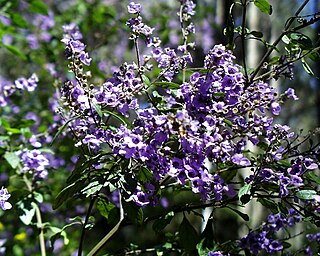
Prostanthera melissifolia, commonly known as balm mint bush, is a species of flowering plant in the family Lamiaceae and is endemic to south-eastern Australia. It is an erect shrub with hairy branches, egg-shaped leaves with fine teeth on the edges and mauve to purple or pink flowers on the ends of branchlets.

Prostanthera eurybioides, commonly known as Monarto mintbush, is a species of flowering plant in the family Lamiaceae and is endemic to the south-east of South Australia. It is a low, spreading shrub with densely hairy branches, thick, elliptic to egg-shaped leaves clustered on short shoots, and violet to mid-purple flowers that are white with orange and dark purple dots inside the petal tube.

Prostanthera magnifica, commonly known as magnificent prostanthera, is a species of flowering plant in the family Lamiaceae and is endemic to Western Australia. It is a slender to spreading, erect shrub that has hairy stems, elliptical to narrow egg-shaped leaves and pale mauve or pale blue to pink flowers with prominent dark mauve to purple sepals.

Prostanthera althoferi is a species of flowering plant in the family Lamiaceae and is endemic to inland areas of Australia. It is an erect shrub with its stems and leaves densely covered with silvery, greyish-green hairs, and has narrow egg-shaped leaves and white to cream-coloured flowers with mauve or purple striations inside.
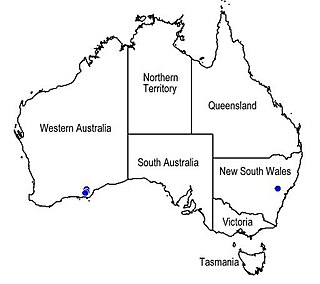
Prostanthera carrickiana, commonly known as Carrick's mintbush, is a species of flowering plant in the family Lamiaceae and is endemic to a restricted area in the south-west of Western Australia. It is an erect shrub with hairy branchlets, elliptical leaves pinkish-red flowers.
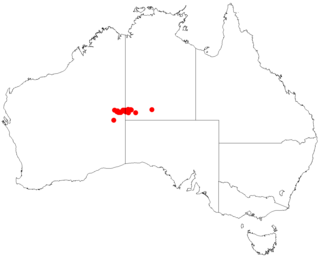
Prostanthera centralis is a species of flowering plant in the family Lamiaceae and is endemic to an area near the border between the Northern Territory and Western Australia. It is an erect shrub with hairy branchlets, hairy egg-shaped to elliptical leaves and mauve to blue flowers.

Prostanthera eungella is a species of flowering plant in the family Lamiaceae and is endemic to the Eungella region in Queensland. It is an erect shrub with narrow egg-shaped leaves with small teeth, and mauve flowers that are white inside the petal tube and arranged in upper leaf axils.

Prostanthera ferricola is a species of flowering plant in the family Lamiaceae and is endemic to central Western Australia. It is an erect, openly branched shrub with aromatic, egg-shaped leaves and mauve-purple flowers arranged in four to twelve leaf axils near the end of branchlets.

Prostanthera incurvata is a species of flowering plant in the family Lamiaceae and is endemic to the inland of Western Australia. It is a small, erect shrub with hairy branches, narrow oblong to narrow egg-shaped leaves with the narrower end towards the base, and pink to red, sometimes yellow flowers.
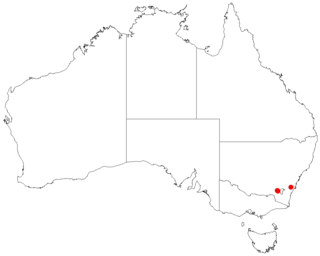
Prostanthera makinsonii is a species of flowering plant in the family Lamiaceae and is endemic to a restricted area of New South Wales. It is a spreading shrub with strongly aromatic, egg-shaped leaves and mostly glabrous purple flowers arranged in bunches of eight to twelve in upper leaf axils.

Prostanthera nanophylla is a species of flowering plant in the family Lamiaceae and is endemic to Western Australia. It is a small shrub with hairy branches, egg-shaped to elliptic or narrow oblong leaves and mauve or blue to white flowers with dull brown, maroon or purple spots.

Prostanthera patens is a species of flowering plant in the family Lamiaceae and is endemic to Western Australia. It is a small shrub with stiff, spine-like, hairy branches, egg-shaped to broadly elliptic, hairy leaves and red and orange to pale red flowers.

Prostanthera petraea is a species of flowering plant in the family Lamiaceae and is endemic to a restricted area near the Queensland–New South Wales border. It is a large shrub to small tree with ridged, glandular branches, egg-shaped leaves and white flowers usually without markings.

Prostanthera petrophila is a species of flowering plant in the family Lamiaceae and is endemic to Western Australia. It is a spreading shrub with densely hairy branches, narrow egg-shaped leaves with the narrower end towards the base and white flowers with violet striations in the petal tube.

Prostanthera scutata is a species of flowering plant in the family Lamiaceae and is endemic to Western Australia. It is a small, erect, compact shrub with densely hairy branches, elliptic to narrow elliptic leaves and pale blue or faintly violet flowers.

Prostanthera semiteres is a species of flowering plant in the family Lamiaceae and is endemic to Western Australia. It is a small shrub with narrow egg-shaped leaves with the narrower end towards the base and pink or red flowers.

Prostanthera sericea, commonly known as silky mintbush or walyuwalyu, is a species of flowering plant in the family Lamiaceae and is endemic to inland Australia. It is an erect shrub with hairy branches, cylindrical leaves and white flowers with mauve or purple streaks.

Prostanthera splendens is a species of flowering plant in the family Lamiaceae and is endemic to Western Australia. It is a small, spreading shrub with small, densely glandular, egg-shaped leaves and mauve to light purple flowers, paler on the inside with mauve to reddish-brown dots.
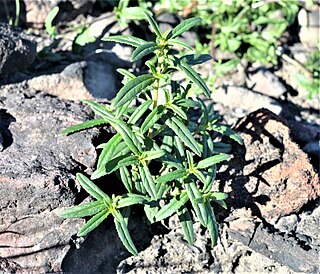
Prostanthera tallowa is a species of flowering plant in the family Lamiaceae and is endemic to the Kangaroo Valley area of New South Wales. It is an erect, aromatic shrub with narrow egg-shaped to linear leaves and mauve to light purple flowers with darker dots inside the petal tube.

Prostanthera verticillaris is a species of flowering plant in the family Lamiaceae and is endemic to a restricted area of Western Australia. It is a spreading shrub with whorled, egg-shaped to elliptic leaves and white to purplish-blue flowers.





















